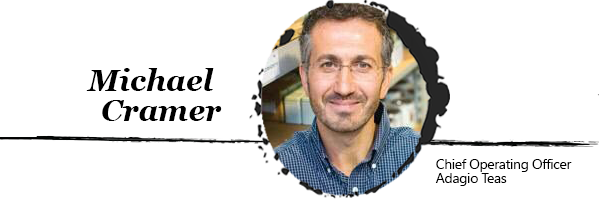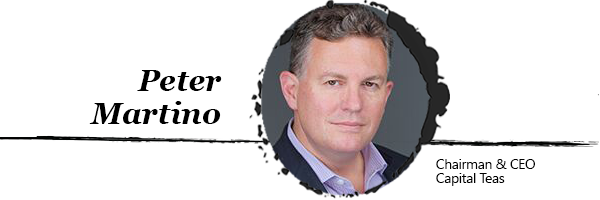Tea was mail-ordered for more than a century. Minimal weight and high margins (up to 70 percent) made it very popular in the early days of the internet. But industry signals are mixed on its future. Last fall Teavana closed its profitable online store (shortly after Starbucks closed its online store for coffee). At the same time 236-store DAVIDsTEA committed $4 million to “a new and more robust e-commerce platform,” deemed as essential for long-term growth. The new e-commerce site launched this spring.
Online sales are brisk at Amazon with Whole Foods bringing its selection of quality teas to the forefront in sample boxes and with innovations such as three-minute “Tea House Meditations” on Amazon Echo created by Pure Leaf Tea.
World Tea News asked our panel of industry leaders:
 The evolution of e-commerce is far less drastic than the seismic changes taking place in physical retail. The two are also converging with fewer pure-play models and more omnichannel strategies. The stores act as “theaters” for brand discovery and exploration, with online commerce best for subsequent transactions and replenishment.
Adagio Tea's website went live in 1999 with a garage full of tea, bedrooms full of tea ware, truck drivers sheepishly asking if they have the right address when making deliveries. "We had the advantage of starting as an online-only retailer, and taking full advantage of the new medium. Companies with existing catalogs transcribed the paper versions online and waited for the phone to ring. We didn’t take phone orders, and so built the site to provide an information-rich and intuitive shopping experience.
From the early days, we understood that commerce is enhanced by rich content and community. Our various community sites (TeaMuse, TeaChat, TeaMap, TeaChef, TeaCritic, etc.) serve this purpose. You can’t outspend Amazon and Walmart in marketing, so you have to find creative ways of reaching consumers who may be interested in your products. Our community sites help us do this, along with our referral program, and a slew of data mining under the hood.
Online sale of tea has low barriers to entry, so new sites pop up all the time. However, scaling the business is hellaciously difficult, with only a handful of companies having reached the point where a large base of customers and efficient supply chains form a virtuous circle of one feeding and enhancing the other.
In 2017 World Tea Expo named Adagio Teas "Best Specialty Tea Brand"
The evolution of e-commerce is far less drastic than the seismic changes taking place in physical retail. The two are also converging with fewer pure-play models and more omnichannel strategies. The stores act as “theaters” for brand discovery and exploration, with online commerce best for subsequent transactions and replenishment.
Adagio Tea's website went live in 1999 with a garage full of tea, bedrooms full of tea ware, truck drivers sheepishly asking if they have the right address when making deliveries. "We had the advantage of starting as an online-only retailer, and taking full advantage of the new medium. Companies with existing catalogs transcribed the paper versions online and waited for the phone to ring. We didn’t take phone orders, and so built the site to provide an information-rich and intuitive shopping experience.
From the early days, we understood that commerce is enhanced by rich content and community. Our various community sites (TeaMuse, TeaChat, TeaMap, TeaChef, TeaCritic, etc.) serve this purpose. You can’t outspend Amazon and Walmart in marketing, so you have to find creative ways of reaching consumers who may be interested in your products. Our community sites help us do this, along with our referral program, and a slew of data mining under the hood.
Online sale of tea has low barriers to entry, so new sites pop up all the time. However, scaling the business is hellaciously difficult, with only a handful of companies having reached the point where a large base of customers and efficient supply chains form a virtuous circle of one feeding and enhancing the other.
In 2017 World Tea Expo named Adagio Teas "Best Specialty Tea Brand"
 Like everything else, online tea needs to be handled as if it is a brick and mortar store, with the same customer care and thoughtfulness and individual attention a customer would receive at a tea house. The only difference is that the hospitality needs to be extended digitally. The company’s background and history are all-important. Tea is available in abundance online and at various prices. The customer’s only assurance that he is receiving authentic, fresh tea from a reputable vendor is by doing a bit of research and reading the background provided online and on the site.
Many tea sites have a minimal "About Us" section, sketchy information for a contact address, a limited tea selection, poor descriptions and high prices. These are tell-tale signs to a customer. Add to that – many vendors open a web store, carry no inventory and only purchase tea after they get a customer’s order. In today’s world with expectations of fast delivery, low shipping costs, and significant competition, this model will fail fast.
We are very bullish on online tea sales but it does take constant re-invention and attention to do all the right things – keep the content updated, maintain high customer service standards, correct errors quickly and agreeably and provide a comprehensive selection of all types of teas – varietals, flavored, Chai blends, herbals and from all origins."
Like everything else, online tea needs to be handled as if it is a brick and mortar store, with the same customer care and thoughtfulness and individual attention a customer would receive at a tea house. The only difference is that the hospitality needs to be extended digitally. The company’s background and history are all-important. Tea is available in abundance online and at various prices. The customer’s only assurance that he is receiving authentic, fresh tea from a reputable vendor is by doing a bit of research and reading the background provided online and on the site.
Many tea sites have a minimal "About Us" section, sketchy information for a contact address, a limited tea selection, poor descriptions and high prices. These are tell-tale signs to a customer. Add to that – many vendors open a web store, carry no inventory and only purchase tea after they get a customer’s order. In today’s world with expectations of fast delivery, low shipping costs, and significant competition, this model will fail fast.
We are very bullish on online tea sales but it does take constant re-invention and attention to do all the right things – keep the content updated, maintain high customer service standards, correct errors quickly and agreeably and provide a comprehensive selection of all types of teas – varietals, flavored, Chai blends, herbals and from all origins."
 My favorite way to buy tea is from a live tea merchant, where I can see, discuss, and taste the teas before purchasing. When that’s not possible, I personally feel more comfortable discovering a new brand and their teas online rather than in the grocery store.
When shopping online, the customer should be able to better see past the packaging. There’s generally far more information available about the tea as well as the brand, and the consumer can usually commit to only a very small initial purchase. In addition, reviews are readily available for most teas sold online, and those give more insight as to what the consumer can expect from the tea, as well as from the company."
At The Tea Spot, we find what works for us is creating an online community presence which is very intimately tied into our customer service and product delivery experience. We work to blur the distinction between buying from us online and meeting us in person at our warehouse, a conference, or a festival. Our goal is to make our site reflective of our values and our mission. We want it to be a resource for consumers interested in discovering tea for improving their health and wellness, as well as for those who are already very familiar with tea and are shopping online to find a good deal on some of their favorites. Our customers are evolving with us, and each year we can offer a broader selection and more connoisseur teas. Because quality and freshness are paramount to us, we can’t stock teas which won’t turn in one season. From what we observe, other online tea stores who work to make shoppers comfortable in their brand and quality are also experiencing success online. Compared to an online Teavana or David’s presence, however, we’re a small company, and can find success in numbers which might not make for a viable business unit within a large company. So what makes for a profitable business channel for us may not be enough to justify the resources that a Starbucks or Davids might need to put behind an online presence for tea.
My favorite way to buy tea is from a live tea merchant, where I can see, discuss, and taste the teas before purchasing. When that’s not possible, I personally feel more comfortable discovering a new brand and their teas online rather than in the grocery store.
When shopping online, the customer should be able to better see past the packaging. There’s generally far more information available about the tea as well as the brand, and the consumer can usually commit to only a very small initial purchase. In addition, reviews are readily available for most teas sold online, and those give more insight as to what the consumer can expect from the tea, as well as from the company."
At The Tea Spot, we find what works for us is creating an online community presence which is very intimately tied into our customer service and product delivery experience. We work to blur the distinction between buying from us online and meeting us in person at our warehouse, a conference, or a festival. Our goal is to make our site reflective of our values and our mission. We want it to be a resource for consumers interested in discovering tea for improving their health and wellness, as well as for those who are already very familiar with tea and are shopping online to find a good deal on some of their favorites. Our customers are evolving with us, and each year we can offer a broader selection and more connoisseur teas. Because quality and freshness are paramount to us, we can’t stock teas which won’t turn in one season. From what we observe, other online tea stores who work to make shoppers comfortable in their brand and quality are also experiencing success online. Compared to an online Teavana or David’s presence, however, we’re a small company, and can find success in numbers which might not make for a viable business unit within a large company. So what makes for a profitable business channel for us may not be enough to justify the resources that a Starbucks or Davids might need to put behind an online presence for tea.
 It appears to me that even several companies who are well-funded in their online sites have not been able to sustain. So, to me, it seems that online tea companies need to look at perseverence, diligent social media, know what differentiates them and who their target market is and, of course, have excellent product and service.
It appears to me that even several companies who are well-funded in their online sites have not been able to sustain. So, to me, it seems that online tea companies need to look at perseverence, diligent social media, know what differentiates them and who their target market is and, of course, have excellent product and service.
 There are three components to a successful online sales approach – you have to get people to your site, convert them to customers, and use metrics to track the process.
For getting to people to the site, the single most important piece is search engine optimization (SEO). It took us a while to realize that that putting up new content to our site wasn't just for humans, it was for the bots scanning the internet. We’re about to launch a blog to do just that; let Google know that we are indeed creating new content. And a small tip -- don't copy content across multiple pages because you get penalized for having duplicate material.
Once you have people on the site, the next step is converting them to customers. We’ve all heard that Millennials are the key demographic for future tea sales, and that they care about stories. The great thing about online retail is that it offers a unique opportunity to tell the story with visuals – a picture is worth 1,000 words and a short, beautiful video is worth 10,000 more. Of course, social media complements that story telling.
Underlying all of this is tracking the right metrics – two of the most important are daily traffic to the site and conversions to customers. It took us a while to get into the habit of regularly checking Google Analytics, but the good news is that its incredibly easy to do once you have things setup. And even if you don't check it for years, all that info is there as long as you install Google Analytics when you start.
In summary, it’s all about increasing traffic to your site, converting traffic into customers through strong visuals that tell a story, and using Google Analytics to track the whole process.
There are three components to a successful online sales approach – you have to get people to your site, convert them to customers, and use metrics to track the process.
For getting to people to the site, the single most important piece is search engine optimization (SEO). It took us a while to realize that that putting up new content to our site wasn't just for humans, it was for the bots scanning the internet. We’re about to launch a blog to do just that; let Google know that we are indeed creating new content. And a small tip -- don't copy content across multiple pages because you get penalized for having duplicate material.
Once you have people on the site, the next step is converting them to customers. We’ve all heard that Millennials are the key demographic for future tea sales, and that they care about stories. The great thing about online retail is that it offers a unique opportunity to tell the story with visuals – a picture is worth 1,000 words and a short, beautiful video is worth 10,000 more. Of course, social media complements that story telling.
Underlying all of this is tracking the right metrics – two of the most important are daily traffic to the site and conversions to customers. It took us a while to get into the habit of regularly checking Google Analytics, but the good news is that its incredibly easy to do once you have things setup. And even if you don't check it for years, all that info is there as long as you install Google Analytics when you start.
In summary, it’s all about increasing traffic to your site, converting traffic into customers through strong visuals that tell a story, and using Google Analytics to track the whole process.
If online offers opportunity, what is the best approach to tap tea sales success online?
 The evolution of e-commerce is far less drastic than the seismic changes taking place in physical retail. The two are also converging with fewer pure-play models and more omnichannel strategies. The stores act as “theaters” for brand discovery and exploration, with online commerce best for subsequent transactions and replenishment.
Adagio Tea's website went live in 1999 with a garage full of tea, bedrooms full of tea ware, truck drivers sheepishly asking if they have the right address when making deliveries. "We had the advantage of starting as an online-only retailer, and taking full advantage of the new medium. Companies with existing catalogs transcribed the paper versions online and waited for the phone to ring. We didn’t take phone orders, and so built the site to provide an information-rich and intuitive shopping experience.
From the early days, we understood that commerce is enhanced by rich content and community. Our various community sites (TeaMuse, TeaChat, TeaMap, TeaChef, TeaCritic, etc.) serve this purpose. You can’t outspend Amazon and Walmart in marketing, so you have to find creative ways of reaching consumers who may be interested in your products. Our community sites help us do this, along with our referral program, and a slew of data mining under the hood.
Online sale of tea has low barriers to entry, so new sites pop up all the time. However, scaling the business is hellaciously difficult, with only a handful of companies having reached the point where a large base of customers and efficient supply chains form a virtuous circle of one feeding and enhancing the other.
In 2017 World Tea Expo named Adagio Teas "Best Specialty Tea Brand"
The evolution of e-commerce is far less drastic than the seismic changes taking place in physical retail. The two are also converging with fewer pure-play models and more omnichannel strategies. The stores act as “theaters” for brand discovery and exploration, with online commerce best for subsequent transactions and replenishment.
Adagio Tea's website went live in 1999 with a garage full of tea, bedrooms full of tea ware, truck drivers sheepishly asking if they have the right address when making deliveries. "We had the advantage of starting as an online-only retailer, and taking full advantage of the new medium. Companies with existing catalogs transcribed the paper versions online and waited for the phone to ring. We didn’t take phone orders, and so built the site to provide an information-rich and intuitive shopping experience.
From the early days, we understood that commerce is enhanced by rich content and community. Our various community sites (TeaMuse, TeaChat, TeaMap, TeaChef, TeaCritic, etc.) serve this purpose. You can’t outspend Amazon and Walmart in marketing, so you have to find creative ways of reaching consumers who may be interested in your products. Our community sites help us do this, along with our referral program, and a slew of data mining under the hood.
Online sale of tea has low barriers to entry, so new sites pop up all the time. However, scaling the business is hellaciously difficult, with only a handful of companies having reached the point where a large base of customers and efficient supply chains form a virtuous circle of one feeding and enhancing the other.
In 2017 World Tea Expo named Adagio Teas "Best Specialty Tea Brand"
—Michael Cramer Chief Operating Officer of Adagio Teas

—Tony Gebely Founder of World of Tea
 Like everything else, online tea needs to be handled as if it is a brick and mortar store, with the same customer care and thoughtfulness and individual attention a customer would receive at a tea house. The only difference is that the hospitality needs to be extended digitally. The company’s background and history are all-important. Tea is available in abundance online and at various prices. The customer’s only assurance that he is receiving authentic, fresh tea from a reputable vendor is by doing a bit of research and reading the background provided online and on the site.
Many tea sites have a minimal "About Us" section, sketchy information for a contact address, a limited tea selection, poor descriptions and high prices. These are tell-tale signs to a customer. Add to that – many vendors open a web store, carry no inventory and only purchase tea after they get a customer’s order. In today’s world with expectations of fast delivery, low shipping costs, and significant competition, this model will fail fast.
We are very bullish on online tea sales but it does take constant re-invention and attention to do all the right things – keep the content updated, maintain high customer service standards, correct errors quickly and agreeably and provide a comprehensive selection of all types of teas – varietals, flavored, Chai blends, herbals and from all origins."
Like everything else, online tea needs to be handled as if it is a brick and mortar store, with the same customer care and thoughtfulness and individual attention a customer would receive at a tea house. The only difference is that the hospitality needs to be extended digitally. The company’s background and history are all-important. Tea is available in abundance online and at various prices. The customer’s only assurance that he is receiving authentic, fresh tea from a reputable vendor is by doing a bit of research and reading the background provided online and on the site.
Many tea sites have a minimal "About Us" section, sketchy information for a contact address, a limited tea selection, poor descriptions and high prices. These are tell-tale signs to a customer. Add to that – many vendors open a web store, carry no inventory and only purchase tea after they get a customer’s order. In today’s world with expectations of fast delivery, low shipping costs, and significant competition, this model will fail fast.
We are very bullish on online tea sales but it does take constant re-invention and attention to do all the right things – keep the content updated, maintain high customer service standards, correct errors quickly and agreeably and provide a comprehensive selection of all types of teas – varietals, flavored, Chai blends, herbals and from all origins."
—Anupa Mueller Founder of Eco-Prima Tea
 My favorite way to buy tea is from a live tea merchant, where I can see, discuss, and taste the teas before purchasing. When that’s not possible, I personally feel more comfortable discovering a new brand and their teas online rather than in the grocery store.
When shopping online, the customer should be able to better see past the packaging. There’s generally far more information available about the tea as well as the brand, and the consumer can usually commit to only a very small initial purchase. In addition, reviews are readily available for most teas sold online, and those give more insight as to what the consumer can expect from the tea, as well as from the company."
At The Tea Spot, we find what works for us is creating an online community presence which is very intimately tied into our customer service and product delivery experience. We work to blur the distinction between buying from us online and meeting us in person at our warehouse, a conference, or a festival. Our goal is to make our site reflective of our values and our mission. We want it to be a resource for consumers interested in discovering tea for improving their health and wellness, as well as for those who are already very familiar with tea and are shopping online to find a good deal on some of their favorites. Our customers are evolving with us, and each year we can offer a broader selection and more connoisseur teas. Because quality and freshness are paramount to us, we can’t stock teas which won’t turn in one season. From what we observe, other online tea stores who work to make shoppers comfortable in their brand and quality are also experiencing success online. Compared to an online Teavana or David’s presence, however, we’re a small company, and can find success in numbers which might not make for a viable business unit within a large company. So what makes for a profitable business channel for us may not be enough to justify the resources that a Starbucks or Davids might need to put behind an online presence for tea.
My favorite way to buy tea is from a live tea merchant, where I can see, discuss, and taste the teas before purchasing. When that’s not possible, I personally feel more comfortable discovering a new brand and their teas online rather than in the grocery store.
When shopping online, the customer should be able to better see past the packaging. There’s generally far more information available about the tea as well as the brand, and the consumer can usually commit to only a very small initial purchase. In addition, reviews are readily available for most teas sold online, and those give more insight as to what the consumer can expect from the tea, as well as from the company."
At The Tea Spot, we find what works for us is creating an online community presence which is very intimately tied into our customer service and product delivery experience. We work to blur the distinction between buying from us online and meeting us in person at our warehouse, a conference, or a festival. Our goal is to make our site reflective of our values and our mission. We want it to be a resource for consumers interested in discovering tea for improving their health and wellness, as well as for those who are already very familiar with tea and are shopping online to find a good deal on some of their favorites. Our customers are evolving with us, and each year we can offer a broader selection and more connoisseur teas. Because quality and freshness are paramount to us, we can’t stock teas which won’t turn in one season. From what we observe, other online tea stores who work to make shoppers comfortable in their brand and quality are also experiencing success online. Compared to an online Teavana or David’s presence, however, we’re a small company, and can find success in numbers which might not make for a viable business unit within a large company. So what makes for a profitable business channel for us may not be enough to justify the resources that a Starbucks or Davids might need to put behind an online presence for tea.
—Maria Uspenski Founder and CEO of The Tea Spot, author of Cancer Hates Tea
 It appears to me that even several companies who are well-funded in their online sites have not been able to sustain. So, to me, it seems that online tea companies need to look at perseverence, diligent social media, know what differentiates them and who their target market is and, of course, have excellent product and service.
It appears to me that even several companies who are well-funded in their online sites have not been able to sustain. So, to me, it seems that online tea companies need to look at perseverence, diligent social media, know what differentiates them and who their target market is and, of course, have excellent product and service.
—Diane Walden Co-Founder of California Tea & Herbal

—Peter Martino Chairman & CEO of Capital Teas
 There are three components to a successful online sales approach – you have to get people to your site, convert them to customers, and use metrics to track the process.
For getting to people to the site, the single most important piece is search engine optimization (SEO). It took us a while to realize that that putting up new content to our site wasn't just for humans, it was for the bots scanning the internet. We’re about to launch a blog to do just that; let Google know that we are indeed creating new content. And a small tip -- don't copy content across multiple pages because you get penalized for having duplicate material.
Once you have people on the site, the next step is converting them to customers. We’ve all heard that Millennials are the key demographic for future tea sales, and that they care about stories. The great thing about online retail is that it offers a unique opportunity to tell the story with visuals – a picture is worth 1,000 words and a short, beautiful video is worth 10,000 more. Of course, social media complements that story telling.
Underlying all of this is tracking the right metrics – two of the most important are daily traffic to the site and conversions to customers. It took us a while to get into the habit of regularly checking Google Analytics, but the good news is that its incredibly easy to do once you have things setup. And even if you don't check it for years, all that info is there as long as you install Google Analytics when you start.
In summary, it’s all about increasing traffic to your site, converting traffic into customers through strong visuals that tell a story, and using Google Analytics to track the whole process.
There are three components to a successful online sales approach – you have to get people to your site, convert them to customers, and use metrics to track the process.
For getting to people to the site, the single most important piece is search engine optimization (SEO). It took us a while to realize that that putting up new content to our site wasn't just for humans, it was for the bots scanning the internet. We’re about to launch a blog to do just that; let Google know that we are indeed creating new content. And a small tip -- don't copy content across multiple pages because you get penalized for having duplicate material.
Once you have people on the site, the next step is converting them to customers. We’ve all heard that Millennials are the key demographic for future tea sales, and that they care about stories. The great thing about online retail is that it offers a unique opportunity to tell the story with visuals – a picture is worth 1,000 words and a short, beautiful video is worth 10,000 more. Of course, social media complements that story telling.
Underlying all of this is tracking the right metrics – two of the most important are daily traffic to the site and conversions to customers. It took us a while to get into the habit of regularly checking Google Analytics, but the good news is that its incredibly easy to do once you have things setup. And even if you don't check it for years, all that info is there as long as you install Google Analytics when you start.
In summary, it’s all about increasing traffic to your site, converting traffic into customers through strong visuals that tell a story, and using Google Analytics to track the whole process.
—Raj Vable Founder of Young Mountain Tea
